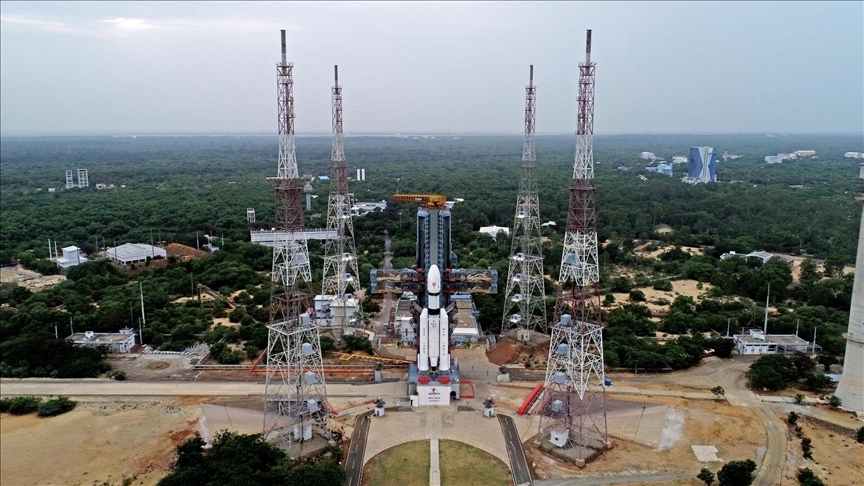

By Anadolu Agency
NEW DELHI
India created history by becoming the first country to land on the lunar south pole and it conducted several space missions in 2023.
But the new year would be “eventful” and likely a “milestone” for the country’s space sector, according to experts and space scientists.
India’s Department of Space plans to undertake many space missions including six Polar Satellite Launch Vehicle missions, missions to launch a meteorology satellite, a navigation satellite and a joint NASA-ISRO Synthetic Aperture Radar satellite which will map the globe in 12 days. ISRO is the Indian Space Research Organization.
Two unmanned missions under India’s Gaganyaan program to validate the human-rated launch vehicle and the orbital module in actual flight, will also take place in 2024.
India’s ambitious Gaganyan mission “envisages demonstration of human spaceflight capability by launching a crew of 3 members to an orbit of 400 km for a three days mission and bringing them back safely to earth, by landing in Indian sea waters.”
Early this week after ISRO launched the X-ray Polarimeter Satellite, also known as XPoSat, the country’s first dedicated polarimetry mission, the agency chief S Somanath said they are planning at least 12 missions this year and it may go “also go up depending on our ability to produce the hardware and complete testing.”
Kailasavadivoo Sivan, former chief of ISRO told Anadolu that in 2024 many missions are lined up including the long-awaited NASA-ISRO SAR mission, being jointly developed by the US space agency and the Indian Space Research Organization.
“Lot of activities would be going on regarding Gangangan. So, 2024, is going to be an eventful year for ISRO as many missions are there,” he said.
India is upbeat with the landmark success last year in the space sector.
After the historic moon landing, the space agency had success by launching a rocket to study the sun — its first such solar mission in September.
As the space sector is expanding exponentially in the government and private sector, Sivan said: “A lot of technical and research and developments are going to be there to meet these targets.”
India aims to send an astronaut to the moon by 2040 and plans include a space station by 2035.
“In the coming years, once we will have a space station and a man on the moon, we will be equal with other nations,” said the former chief.
2023 success boomed industry
Pawan Chandana, co-founder and chief executive officer of Skyroot Aerospace, a private aerospace firm based in southern India, told Anadolu that the country is “expected to attract more global joint ventures, investments, collaborations and partnerships in 2024 and beyond.”
“As international demand for Indian space solutions continues to grow, it fuels a dynamic environment of technological innovation that bridges the government and private sectors,” he said.
Chandana said the Indian private space industry, while relatively new, “is rapidly gaining momentum and quickly catching up with leading spacefaring nations in the private sector.”
“With these demonstrated capabilities, India is poised to attract investments, business opportunities, and funding inflows that will not only benefit the country’s space sector but also bolster its private space endeavors,” he said.
“This influx of support will serve as a catalyst for advancing space technologies, as the private space sector is now well-equipped to act as dependable project and supply partners for national agencies pursuing ambitious goals in space exploration and development,” said Chandana.
The size of India’s space economy is estimated at around $8.4 billion. As per various global estimates, the sector is projected to grow at 6% – 8 % in the coming years.
For nearly six decades, India’s space program has seen the country evolve from a nation relying on foreign launch vehicles to becoming fully self-reliant with its indigenous launch capabilities, according to the government.
The number of foreign and domestic satellites launched by India in the past 20 years was 429 and 10, respectively.
Need to prove technology
Space scientist Chaitanya Giri told Anadolu that things in the industry “look quite upbeat” for the Indian space program from the point of view that “we now have three different parallel tracks i.e. civilian, industry, and military track.”
“What has happened in the first four years after the space reforms were initiated by the government, there is now a great emphasis on encouraging, handholding, facilitating and sort of promoting the Indian private industry … some of them are now able to offer services which have never been attended earlier in India,” said the scientist, based in western India.
Even though startups are coming, he said, the existing ones also need to grow.
“They need to prove their technology,” he said.
Amid a “boom” in the Indian space sector, Giri said the coming years “will be very big for ISRO which is focusing on cutting edge missions.”
“2024 would be a milestone year for both the government and private sector. For the government, there is Gaganyaan which is very important. For private sectors, there are very important product demonstrations lined up in the year,” he added.
We use cookies on our website to give you a better experience, improve performance, and for analytics. For more information, please see our Cookie Policy By clicking “Accept” you agree to our use of cookies.
Read More